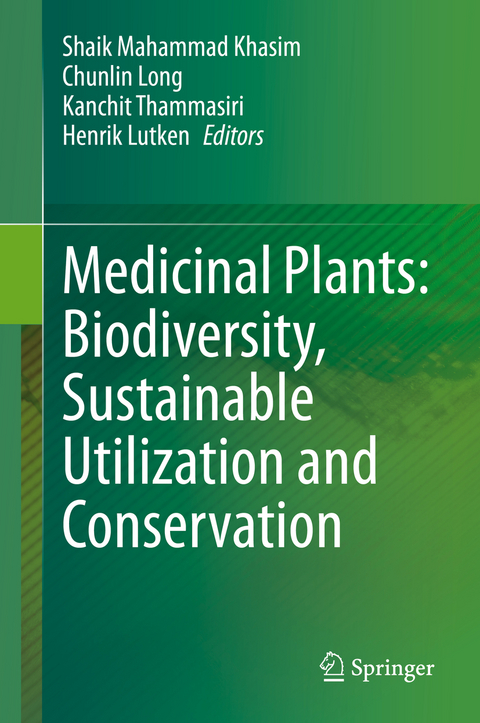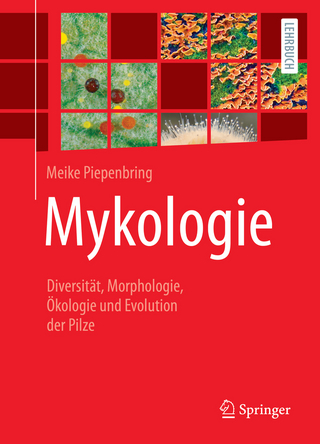
Medicinal Plants: Biodiversity, Sustainable Utilization and Conservation
Springer Verlag, Singapore
978-981-15-1635-1 (ISBN)
Professor Shaik Mahammad Khasim (Acharya Nagarjuna University, India) graduated from Andhra University, Visakhapatnam and holds a Post-Graduate degree from Sardar Patel University, Vallabh Vidyanagar, Gujarat. He obtained his Ph.D. in 1987 from Nagarjuna University and specialized in Orchid taxonomy, anatomy and ecology. He made significant contribution in Biodiversity of medicinal plants and Orchid biology, especially molecular characterization, Ethnomedicine and phytochemistry of Angiosperms.He published 60 research papers in National and International journals. He is recipient of Usha Vij Memorial Award 2018 of The Orchid Society of India (TOSI) for his outstanding contribution in Orchid Art and Science, and Associate Fellow of A.P. Academy of Science, India. He is Founder Member of TOSI, Life Member of Indian Science Congress Association (ISCA), Calcutta (India) and Member of the International Society for Horticultural Science (Belgium). Professor Chunlin Long from Minzu University of China, Beijing, graduated from Hunan Normal University, China and holds Post-Graduate degree from Kunming Institute of Botany, Chinese Academy of Sciences, China. He obtained his Ph.D. in 2002 from Gifu University, Japan. He made significant contribution in fields of agrobiodiversity, ethnobotany and ethnoecology, phytochemistry and natural products and, plant taxonomy and phylogeny. He published 356 papers in national and international journals He is a prolific writer and authored 22 books and 17 patents of innovations in his kit. He established international collaborations with 12 countries. He has been awarded 17 prizes including First-Grade prizes by Yunnan Provincial Government, Chinese Academy of Sciences, and Society of Ethnobotanists. He is also the Vice-President of Chinese Society of Ethnobotany and Vice-Chair of Ethnoecology, Ecological Society of China. Dr. K. Thammasiri (Mahidol University, Bangkok, Thailand) graduated in Agriculture from Kasetsart University, Bangkok and holds Post-Graduation in Agriculture from the same university. He made significant contribution in the fields of Cryopreservation, breeding and tissue culture of orchids and plant genetic resources & conservation. His current research involves Oorchid breeding and micropropagation of selected genera, such as cattleya alliance, dendrobiums, phalaenopsis and vandaceous-type orchids and cryopreservation of Thai orchid species. Presently he is holding the position of Associate Professor, Department of Plant Science, Faculty of Science, Mahidol University, Bangkok, Thailand. Dr. Henrik Lütken (University of Copenhagen, Denmark) Post-Graduated from University of Copenhagen, Denmark. He obtained his Ph.D. in 2007 from the same university. He has during his PhD and PostDoc conducted studies abroad in Germany (Max-Planck Institute, Golm), South Africa (University of Stellenbosch) and Norway (Bioforsk, Aas). He made significant contribution in the field of Genetic engineering, Molecular biology of Ornamental plants, Tissue culture and biotransformation. He published 45 research papers in International journals His outstanding contribution on Agrobacterium rhizogenes got patented in 2016 with United States Patent Trademark Office. He has been the Coordinator of the Crop Science Section Lab-Unit since 2012 and also the Coordinator of DFFResearch Project 1 and also Knowledge Voucher funded by Government of Denmark. He actively participated in Workshop in ‘Protected Skills of Competitive Project Proposal’, Helsinki, Finland and ‘Work Environment Course for Leaders’, Denmark.
Part 1. Biodiversity and Conservation.- Chapter 1. Biodiversity of medicinal plants in the Eastern Ghats of Northern Andhra Pradesh, India.- Chapter 2. Biodiversity, Conservation and Medicinal Uses of Seaweeds: The Glimpses.- Chapter 3. Tree Flora of Andhra Pradesh, India.- Chapter 4. Genetic diversity and variability analysis in sweet flag (Acorus calamus L.).- Chapter 5. Flora of Mangrove species utilized for ethnomedicinal practices in Gautami Godavari estuary, Andhra Pradesh, India.- Chapter 6. Tree diversity assessment in sacred groves of Eastern Ghats, Visakhapatnam district, Andhra Pradesh, India. Part 2. Ethnobotany and Ethnomedicine.- Chapter 7. Structure design and establishment of database application system for Miao medicinal plants in Guizhou Province, China.- Chapter 8. Documentation and Protection of Traditional Knowledge.- Chapter 9. Ethnobotanical assessment of medicinal plants used by Indigenous people living around the Sacred Groves of East Godavari District, AndhraPradesh, India.- Chapter 10. Ethno-botanico-medicine in treatment of diabetes by the tribal groups of Visakhapatnam District, Andhra Pradesh, India.- Chapter 11. Ethnomedicine from Konda Reddis of High Altitude Agency Tracts of East Godavari District, Andhra Pradesh, India.- Chapter 12. A traditional use of plants for the treatment of bone fractures by the local people of West Sikkim, India.- Chapter 13. God’s tree: A culturally coded strategy for conservation (A case study of Gairsain eco- region of district Chamoli, Uttarakhand).- Chapter 14. Ethnomedicinal plants used by ethnic people in Eastern Ghats of Visakhapatnam district, Andhra Pradesh, India.- Chapter 15. Ethnobotany of medicinal plants of Eastern Ghats of Andhra Pradesh for identification of plants with antitumour and antimicrobial potential.- Chapter 16. Controlling biological infestations in museums by medicinal plants.- Chapter 17. Hitherto unexplored aspects of medicinal plants from Ayurveda and Vrikshayurveda.- Chapter18. Ethno veterinary medicinal plants and practices in Andaman and Nicobar Islands.- Chapter 19. Ethnobotanical trees of Sri Lankamalleswara wild life sanctuary, Eastern Ghats, Andhra Pradesh.- Chapter 20. A Study on Medical Systems for Dengue Fever.- Part 3. Bioactive compounds from plants and microbes.- Chapter 21. Development of immunoassays for Ginsenosides in Ginseng.- Chapter 22. Elicitation of flavonoids in Kalanchoë pinnata by Agrobacterium rhizogenes-mediated transformation and UV-Bradiation.- Chapter 23. Biogenic silver nanoparticles from Trametes ljubarskyi (white rot fungus): efficient and effective anti candidal activity.- Chapter 24. Herbal medicinal markets in China: An Ethnobotanical Survey.- Chapter 25. Phyto chemical constituents and pharmacological activities of a traditional medicinal plant Glochidion eriocarpum (Phyllanthaceae).- Chapter 26. Endophytic fungi and their impact on Agroecosystems.- Chapter 27. GC-MS and Insilico molecular docking analysis of secondary metabolites present in leaf extract of Cassia occidentalis Linn.- Chapter 28. Protective effect of Mimusops elengi L. on renal and hepatic markers in STZ-induced diabetic Rats.- Chapter 29. Extraction and purification of gymnemic acid from Gymnema sylvestre r.br.- Chapter 30. GC-MS Profile of the unsaponifiable and saponifiable matters of Coldenia procumbens Linn. Leaves.- Chapter 31. Isolation of sterols from the bark hexane extract of Cordia dichotoma.- Chapter 32. Isolation and characterization of pharmacologically active tannins from stem bark of Syzygium samarangense.- Chapter 33. Rare actinobacteria Nocardiopsis lucentensis VLK-104 isolated from Mangrove ecosystem of Krishna district, Andhra Pradesh.- Chapter 34. Aegle marmelos (Rutaceae): evaluation of root phytochemical constituents for antimicrobial activity.- Chapter 35. Qualitative and quantitative phytochemical studies in different parts of Sesamum indicum L.- Chapter 36. Phytochemical investigation and comparative evaluation of various market samples of Triphala powder with references to their free scavenging and anti-diabetic activity – an in-vitro-approach.- Chapter 37. In vitro anticancer activity of Canthium parviflorum Lam extracts against cancer cell lines.- Chapter 38. Bioactive Metabolites from Streptomyces nanhaiensis VSM-1: Polyphasic taxonomy, Optimization and Evaluation of antimicrobial metabolites by GC-MS analysis.- Chapter 39. In vitro cultured cells as an option for enhancing the production of bioactive compounds: Some selected case studies.- Chapter 40. Anti-Diabetic Studies of the leaf extract of Ericostemma littorale (Blume) using Wistar Rats.- Part 4. Biotechnology.- Chapter 41. Molecular and cytogenetical approaches for genetic diversity analysis of wild and cultivated medicinal plant species from North-East India with focus on genus Curcuma.- Chapter 42. Mutagenic effect of chemicals on certain biochemical parameters in two cultivars of sunflower ( Helianthus annuus L.).- Chapter 43. Mutagenic effectiveness and efficiency of Gamma rays in Musk okra (Abelmoschus moschatus L.).- Chapter 44. Detection of genetic variation in Biophytum sensitivum Linn. by RAPD and ISSR markers.- Chapter 45. Development of standard protocols for in vitro regeneration of some selected banana cultivars (Musa spp.) from India.- Chapter 46. In vitro method of high frequency plant regeneration through internodal callus of Ruta Graveolens L.- Chapter 47. Conservation of an endangered medicinal forest tree species, Oroxylum indicum L. Kurz through in vitro culture- A review.- Chapter 48. DNA barcode: the genetic blue print for identity and diversity of Phyllanthus amarus Schum. et. Thonn.- Chapter 49. Microbiological and physicochemical quality of potable water in valasi, agency area, Andhra Pradesh.
| Erscheinungsdatum | 15.04.2020 |
|---|---|
| Zusatzinfo | 119 Illustrations, color; 95 Illustrations, black and white; XXIII, 829 p. 214 illus., 119 illus. in color. |
| Verlagsort | Singapore |
| Sprache | englisch |
| Maße | 155 x 235 mm |
| Themenwelt | Naturwissenschaften ► Biologie ► Botanik |
| Naturwissenschaften ► Biologie ► Ökologie / Naturschutz | |
| Technik ► Umwelttechnik / Biotechnologie | |
| ISBN-10 | 981-15-1635-9 / 9811516359 |
| ISBN-13 | 978-981-15-1635-1 / 9789811516351 |
| Zustand | Neuware |
| Informationen gemäß Produktsicherheitsverordnung (GPSR) | |
| Haben Sie eine Frage zum Produkt? |
aus dem Bereich


